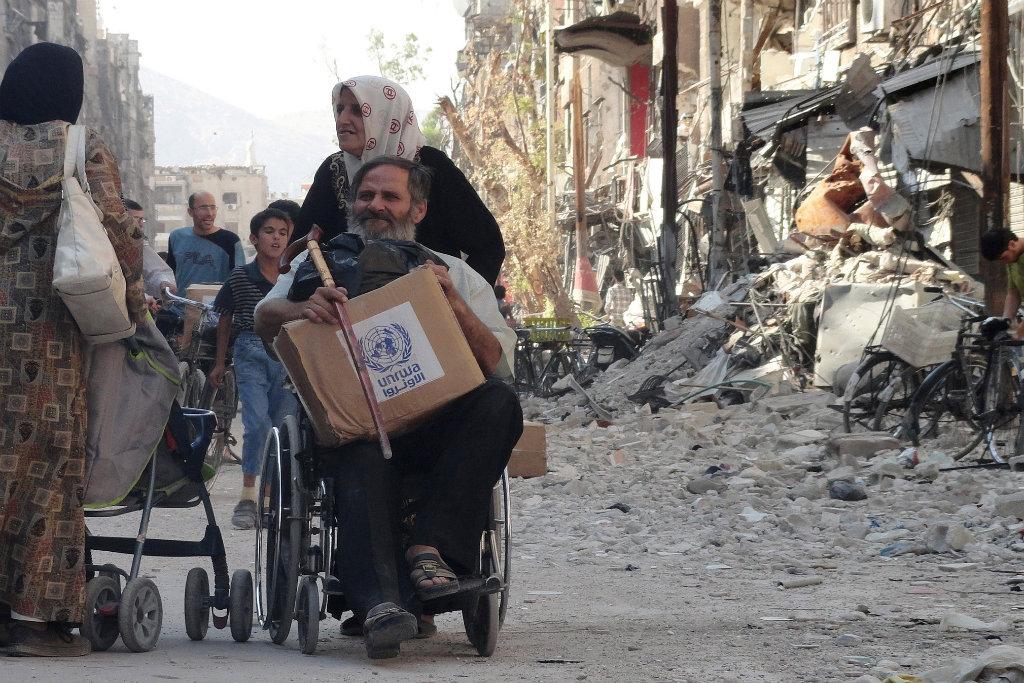Aid groups ‘stretched very thin’ as conflicts persist in Middle East
Residents of Syria’s Yarmuk Palestinian refugee camp, south of Damascus, collect aid food.
Though the latest round of fighting in Gaza began barely four weeks ago, the crisis already has taken a toll on the United Nations' ability to respond to the vast humanitarian needs across the Middle East, the UN Relief and Works Agency (UNRWA) said.
“In less than a month, we have lost eleven of our own,” said Salvatore Lombardo, the agency’s director for external relations and communications. Almost 270,000 displaced Palestinians are living in 90 UNRWA shelters across Gaza, he added.
“While designated emergency shelters were originally equipped to accommodate 500 people, these facilities are now accommodating more than 2,000 people,” he said.
It’s not just the UN. Other humanitarian groups are feeling the weight of supporting the growing number of victims and refugees in Gaza as other conflicts persist in the Middle East. Aid workers say relief efforts face not only shrinking supplies of manpower, food, water and funding, but also the diluted attention of the media, policymakers and donors.
“[We are] being stretched very thin by a number of disaster responses,” said Lawren Sinnema, humanitarian and emergency affairs program management officer at World Vision, an international Christian nonprofit that aids children and their families in times of poverty, war and calamity.
The UNRWA estimates that Gaza alone will need about $190 million to provide emergency assistance for an anticipated 250,000 people displaced for up to eight weeks, Lombardo said.
More than 1,800 have been killed and more than 9,000 hurt in the Strip since fighting intensified in early July, according to CNN’s coverage of the conflict. The wounded and dying cram into hospitals with overwhelmed staff and inadequate supplies. Electricity has been out since Tuesday last week, when Israeli fire struck Gaza’s only power plant.
“The entire medical system is working under a lot of pressure,” said Maria Cecilia Goin, spokesperson for the International Committee of the Red Cross (ICRC) in Gaza. “[Everyone is] completely tired, completely exhausted.”
Meanwhile, the conflict in Syria – just over the border from Palestine – remains “the world's largest humanitarian crisis, in terms of the number of people affected and in need of assistance,” the EU said in a statement last week.
More than 9 million people in Syria and another nearly 3 million refugees spread across Jordan, Lebanon, Turkey, Iraq and Egypt currently require aid, the EU said.
The war between President Bashar Assad’s administration and the opposition Free Syrian Army, begun in 2011, shows no signs of slowing down: As recently as Sunday, 130 civilians died in air and ground operations reportedly carried out by forces loyal to the Assad government. Another 14 Syrian refugees were killed when fighting erupted in the Lebanese border town of Arsal.
“The whole humanitarian community is asking, ‘How do we respond to a growing number of emergencies?’” Sinnema said.
World leaders have tried to show continuing support for victims of both the Syrian war and the Gaza conflict. Last week, the European Union announced an additional $67 million while US Secretary of State John Kerry guaranteed another $378 million to aid both those suffering within Syria and the millions displaced since the war began in 2011.
The United States also pledged $47 million in aid to the Gaza Strip last month.
While international funding is welcome, securing it is just one part of the work that has strained humanitarian groups, said Karl Schembri, Middle East regional media manager for Save the Children, an international nonprofit that supports children in developing countries and promotes children’s rights.
For one thing, distributing resources is difficult when tensions in an area are still high, as in Gaza, he said. Medical teams from relief groups have had to coordinate between Hamas and the Israeli government before taking the wounded to hospitals, the ICRC’s Goin told GlobalPost last week.
Then there are the children. Almost 26 percent of the 3 million refugees out of Syria are under 18, according the UN High Commissioner for Refugees (UNHCR). In Gaza, minors make up more than half the population of 1.8 million.
These children need to be fed, clothed and sheltered, Schembri said. They also need psychosocial support and counseling, as well as safe spaces to continue their education and their lives. To do that, organizations such as Save the Children and World Vision have to provide trained staff, educational materials and secure shelters.
Supporting the needs of children in war zones “brings with it a wider discussion on how to channel the funds we have,” Schembri said.
The length and intensity of a conflict affect donor interest and media attention, as well. With Gaza currently dominating headlines, for instance, Syria has received much less media mileage.
“There’s a tendency to focus on the latest crisis,” World Vision’s Sinnema said.
And if the new cease-fire in effect between Hamas and the Israeli government leads to a longer-lasting peace, attention could shift from Gaza to other world events.
“The cameras will shut off and we’ll have to deal with thousands of people homeless and traumatized,” Schrembi said of their work in the Middle East. “The challenge will be keeping the attention from the donors and the public.”
More on GlobalPost: 'This is the Holy Land, and there will never be peace here'
